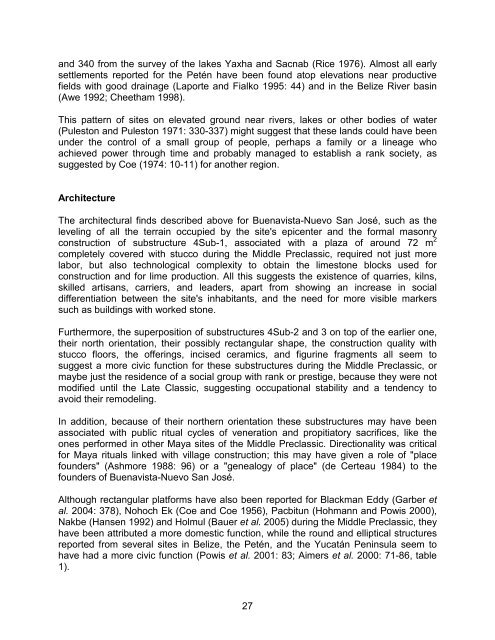Buenavista-Nuevo San José, Petén, Guatemala: Another ... - Famsi
Buenavista-Nuevo San José, Petén, Guatemala: Another ... - Famsi
Buenavista-Nuevo San José, Petén, Guatemala: Another ... - Famsi
You also want an ePaper? Increase the reach of your titles
YUMPU automatically turns print PDFs into web optimized ePapers that Google loves.
and 340 from the survey of the lakes Yaxha and Sacnab (Rice 1976). Almost all early<br />
settlements reported for the <strong>Petén</strong> have been found atop elevations near productive<br />
fields with good drainage (Laporte and Fialko 1995: 44) and in the Belize River basin<br />
(Awe 1992; Cheetham 1998).<br />
This pattern of sites on elevated ground near rivers, lakes or other bodies of water<br />
(Puleston and Puleston 1971: 330-337) might suggest that these lands could have been<br />
under the control of a small group of people, perhaps a family or a lineage who<br />
achieved power through time and probably managed to establish a rank society, as<br />
suggested by Coe (1974: 10-11) for another region.<br />
Architecture<br />
The architectural finds described above for <strong>Buenavista</strong>-<strong>Nuevo</strong> <strong>San</strong> <strong>José</strong>, such as the<br />
leveling of all the terrain occupied by the site's epicenter and the formal masonry<br />
construction of substructure 4Sub-1, associated with a plaza of around 72 m 2<br />
completely covered with stucco during the Middle Preclassic, required not just more<br />
labor, but also technological complexity to obtain the limestone blocks used for<br />
construction and for lime production. All this suggests the existence of quarries, kilns,<br />
skilled artisans, carriers, and leaders, apart from showing an increase in social<br />
differentiation between the site's inhabitants, and the need for more visible markers<br />
such as buildings with worked stone.<br />
Furthermore, the superposition of substructures 4Sub-2 and 3 on top of the earlier one,<br />
their north orientation, their possibly rectangular shape, the construction quality with<br />
stucco floors, the offerings, incised ceramics, and figurine fragments all seem to<br />
suggest a more civic function for these substructures during the Middle Preclassic, or<br />
maybe just the residence of a social group with rank or prestige, because they were not<br />
modified until the Late Classic, suggesting occupational stability and a tendency to<br />
avoid their remodeling.<br />
In addition, because of their northern orientation these substructures may have been<br />
associated with public ritual cycles of veneration and propitiatory sacrifices, like the<br />
ones performed in other Maya sites of the Middle Preclassic. Directionality was critical<br />
for Maya rituals linked with village construction; this may have given a role of "place<br />
founders" (Ashmore 1988: 96) or a "genealogy of place" (de Certeau 1984) to the<br />
founders of <strong>Buenavista</strong>-<strong>Nuevo</strong> <strong>San</strong> <strong>José</strong>.<br />
Although rectangular platforms have also been reported for Blackman Eddy (Garber et<br />
al. 2004: 378), Nohoch Ek (Coe and Coe 1956), Pacbitun (Hohmann and Powis 2000),<br />
Nakbe (Hansen 1992) and Holmul (Bauer et al. 2005) during the Middle Preclassic, they<br />
have been attributed a more domestic function, while the round and elliptical structures<br />
reported from several sites in Belize, the <strong>Petén</strong>, and the Yucatán Peninsula seem to<br />
have had a more civic function (Powis et al. 2001: 83; Aimers et al. 2000: 71-86, table<br />
1).<br />
27
















